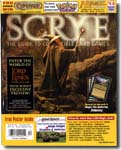 Duel
to the Death with Shaolin Showdown's Faceoff Rules
Duel
to the Death with Shaolin Showdown's Faceoff Rulesby David Eber
copyright 2001 by Krause Publications (Scrye Magazine)
Shadowfist
Duel to the Death (Faceoff Introduction)
by David Eber
Home
> Strategy > Shadowfist Duel to the Death
(Faceoff Introduction)
[posted 29 Aug 2004; updated 8 Apr 2005]
Copyright 2001 by Krause Publishing. This article originally appeared in Scrye Magazine [www.collect.com, 29 Aug 2004] issue #8.8 (Nov/Dec 2001). All rights reserved. Reprint here is by permission of both David and Krause Publishing. Thanks!
 Duel
to the Death with Shaolin Showdown's Faceoff Rules
Duel
to the Death with Shaolin Showdown's Faceoff Rules|
|
One of the staples of the classic kung fu film is the moment when the hero and the villain meet for a final, face-to-face, duel to the death. Shaolin Showdown, the latest Shadowfist expansion, brings this element to the game with the addition of a new rule: The Faceoff. The four new Faceoff cards - Tiger vs. Crane, Eagle vs. Snake, Bear vs. Fox, and Spider vs. Mantis - represent critical battles between Guiding Hand masters and Ascended killers in the storyline. In game terms, these cards allow you to initiate a combat between two characters outside of the normal attack rules. No other characters can interfere with this combat, and the player who controls the winning character gains an immediate reward.
The most important thing to remember about Faceoffs is that they don't work like regular attacks. What you have are two characters dealing combat damage to each other, and so there is no attacker or defender. As such, a lot of the things that work in a normal attack, like Ambush or Iron and Silk, won't work in a Faceoff. Also, unlike attacks, you and your opponents don't have the opportunity to generate multiple scenes (i.e. sequences of effects) before combat occurs. Once the Faceoff is played, the players only have one scene in which to generate effects. Finally, when you create a Faceoff between two characters, you can only target an opponent's character with a Fighting no lower than two less than your character, because it just isn't much of a challenge to have Draco beat up on a lowly Gardener.
So what good are Faceoffs? Why not just attack? Well, there are a couple of reasons. Faceoffs are great for taking out small, well-protected utility characters like the Vivisector or Arcanotechnician. They work nicely against players who sit on defense, and as such, they help to break up stalemates. Since the Faceoff cards are events, you can play them outside your own turn, creating a combat at an unexpected moment, and you can play them after a failed attack as well. And finally, Faceoffs are useful simply because they give the Hand and the Ascended something they've mostly been lacking: a way to kill off opposing characters outside of an attack.
While it's easy to take out a weaker character using Faceoff events, the key to getting the most mileage out of them is to use them with cards that allow your characters to come through the combat relatively unscathed, or better yet, to take on and defeat larger characters and still survive. The Guiding Hand have a wide variety of options to achieve this: Armored in Life, Green Senshi Chamber, Path of the Storm Turtle, Yellow Senshi Chamber, Righteous Protector, Superior Kung Fu, and "Try My Kung Fu" all work well in a Faceoff. The Ascended have fewer options, but they have the best Faceoff support card there is: Operation Killdeer. The Military Commandant and Opium Den are both excellent cards to use in a Faceoff as well.
Faceoff cards aren't obvious power cards, but they do add an interesting new twist to the game. They may seem a little daunting at first, but once you've used them a few times, the possibilities begin to open up. The best thing to do is to try them out, and see what kind of combinations you can come up with yourself.
David Eber, 2001.
Legal Stuff | Terms of Use | Privacy Policy | About Me | Contact Me